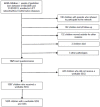Assessing Behavioral Disorders with SDQ in Very Preterm Children at 5 Years of Age in LIFT Cohort
- PMID: 37508688
- PMCID: PMC10378436
- DOI: 10.3390/children10071191
Assessing Behavioral Disorders with SDQ in Very Preterm Children at 5 Years of Age in LIFT Cohort
Abstract
Background: Preterm-born children are at risk of behavioral disorders and the systematic assessment of these disorders remains a challenge. Questions remain about the accuracy of self-reported parent questionnaires and the real everyday life behavior of the child.
Aim: To evaluate the association between SDQ reported by parents in the preterm and behavioral difficulties in the everyday school life environment reported by teacher.
Methods: All children born before 33 weeks and who followed-up in the LIFT (Loire Infant Follow-up team) network were included. The Strengths and Difficulties Parental Questionnaire (SDQ), completed at 5 years, was used to check for behavioral difficulties and identified three groups: "normal", "borderline" and "abnormal". Then, the SDQ results were compared to the Global School Adaptation Score (GSA) at 5 years.
Results: Out of the 1825 children followed in the cohort at the age of 5, 1397 questionnaires were analyzed. A total of 11.1% of children had an abnormal score, and 9.7% had a borderline score. Male gender and a lower birth weight z-score were significantly associated with the "abnormal SDQ" group. There is a significant relationship between the probability of being in the "abnormal SDQ" group at 5 years and with difficulty in global school adaptation at 5 years, as well as an SDQ borderline score in the preterm (p < 0.001).
Conclusions: SDQ abnormal and borderline scores are associated with behavioral difficulties in the classroom and everyday life behavior. In preterm children, one should be alerted even by a borderline SDQ score.
Keywords: SDQ; behavior; functional development outcome; preterm.
Conflict of interest statement
The authors declare no conflict of interest.
Figures
References
-
- Larroque B., Ancel P.-Y., Marret S., Marchand L., Roze J.C., Kaminski M. Neurodevelopmental disabilities and special care of 5-year-old children born before 33 weeks of gestation (the EPIPAGE study): A longitudinal cohort stydy. Lancet. 2008;371:813–820. doi: 10.1016/S0140-6736(08)60380-3. - DOI - PubMed
-
- Linsell L., Johnson S., Wolke D., Morris J., Kurinczuk J.J., Marlow N. Trajectories of behavior, attention, social and emotional problems from childhood to early adulthood following extremely preterm birth: A prospective cohort study. Eur. Child Adolesc. Psychiatry. 2019;28:531–542. doi: 10.1007/s00787-018-1219-8. - DOI - PMC - PubMed
LinkOut - more resources
Full Text Sources



